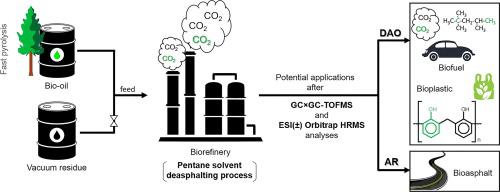Our official English website, www.x-mol.net, welcomes your feedback! (Note: you will need to create a separate account there.)
Chemical speciation of petroleum and bio-oil coprocessing products: Investigating the introduction of renewable molecules in refining processes
Fuel ( IF 7.4 ) Pub Date : 2021-03-01 , DOI: 10.1016/j.fuel.2020.119654 Nathália S. Pontes , Raquel V.S. Silva , Vitor L. Ximenes , Andrea R. Pinho , Débora A. Azevedo
Fuel ( IF 7.4 ) Pub Date : 2021-03-01 , DOI: 10.1016/j.fuel.2020.119654 Nathália S. Pontes , Raquel V.S. Silva , Vitor L. Ximenes , Andrea R. Pinho , Débora A. Azevedo

|
Abstract The pentane solvent deasphalting (SDA) process was carried out with petroleum vacuum residue (VR) blend with a bio-oil (BO) and solely with the bio-oil as a raw material. Two fractions each were produced: deasphalted oil (DAO) and asphaltic residue (AR). This study deals with the chemical speciation of the fractions and investigation of the insertion of renewable molecules in the VR. Chemical characterization was performed by two high-resolution techniques: GC × GC-TOFMS and ESI(±)-Orbitrap HRMS. The GC × GC-TOFMS data showed that all fractions are mixtures of hydrocarbons and heteroatomic midpolar to polar compounds containing a wide variety of chemical functions. Aliphatic hydrocarbons were detected only in DAO fractions, showing that in the SDA process, the extraction of these compounds constituents of the VR was not affected by bio-oil inclusion. The ESI(±)-Orbitrap HRMS results allowed for the identification of nitrogen, oxygen, sulfur, and mixed heteroatomic classes. The chemical speciation obtained by the use of both techniques allowed the evaluation of effect of the SDA process on the fractions and assisted in the investigation of the degree of insertion of renewable molecules in SDA fractions, making them attractive in the application of refining processes, such as catalytic cracking. The DAO from the blend raw material was inserted in a bench-scale catalytic cracking load obtaining satisfactory results, and the AR fraction was introduced as an asphalt cement additive with promising results achieved in asphalt aging tests.
中文翻译:

石油和生物油协同加工产品的化学形态:研究在精炼过程中引入可再生分子
摘要 戊烷溶剂脱沥青 (SDA) 工艺是将石油减压渣油 (VR) 与生物油 (BO) 共混,并仅以生物油为原料进行的。分别生产两种馏分:脱沥青油 (DAO) 和沥青残渣 (AR)。这项研究涉及馏分的化学形态和可再生分子在 VR 中插入的研究。通过两种高分辨率技术进行化学表征:GC × GC-TOFMS 和 ESI(±)-Orbitrap HRMS。GC × GC-TOFMS 数据显示所有馏分都是烃和杂原子中极性到极性化合物的混合物,包含多种化学功能。仅在 DAO 馏分中检测到脂肪烃,表明在 SDA 过程中,VR中这些化合物成分的提取不受生物油夹杂物的影响。ESI(±)-Orbitrap HRMS 结果允许识别氮、氧、硫和混合杂原子类别。通过使用这两种技术获得的化学形态允许评估 SDA 过程对馏分的影响,并有助于研究可再生分子在 SDA 馏分中的插入程度,使它们在精炼工艺的应用中具有吸引力,例如如催化裂化。将混合原料中的 DAO 插入到实验室规模的催化裂化负载中,获得了令人满意的结果,并且引入了 AR 部分作为沥青水泥添加剂,在沥青老化试验中取得了可喜的结果。ESI(±)-Orbitrap HRMS 结果允许识别氮、氧、硫和混合杂原子类别。通过使用这两种技术获得的化学形态允许评估 SDA 过程对馏分的影响,并有助于研究可再生分子在 SDA 馏分中的插入程度,使它们在精炼工艺的应用中具有吸引力,例如如催化裂化。将混合原料中的 DAO 插入到实验室规模的催化裂化负载中,获得了令人满意的结果,并且引入了 AR 部分作为沥青水泥添加剂,在沥青老化试验中取得了可喜的结果。ESI(±)-Orbitrap HRMS 结果允许识别氮、氧、硫和混合杂原子类别。通过使用这两种技术获得的化学形态允许评估 SDA 过程对馏分的影响,并有助于研究可再生分子在 SDA 馏分中的插入程度,使它们在精炼工艺的应用中具有吸引力,例如如催化裂化。将混合原料中的 DAO 插入到实验室规模的催化裂化负载中,获得了令人满意的结果,并且引入了 AR 部分作为沥青水泥添加剂,在沥青老化试验中取得了可喜的结果。通过使用这两种技术获得的化学形态允许评估 SDA 过程对馏分的影响,并有助于研究可再生分子在 SDA 馏分中的插入程度,使它们在精炼工艺的应用中具有吸引力,例如如催化裂化。将混合原料中的 DAO 插入到实验室规模的催化裂化负载中,获得了令人满意的结果,并且引入了 AR 部分作为沥青水泥添加剂,在沥青老化试验中取得了可喜的结果。通过使用这两种技术获得的化学形态允许评估 SDA 过程对馏分的影响,并有助于研究可再生分子在 SDA 馏分中的插入程度,使它们在精炼工艺的应用中具有吸引力,例如如催化裂化。将混合原料中的 DAO 插入到实验室规模的催化裂化负载中,获得了令人满意的结果,并且引入了 AR 部分作为沥青水泥添加剂,在沥青老化试验中取得了可喜的结果。
更新日期:2021-03-01
中文翻译:

石油和生物油协同加工产品的化学形态:研究在精炼过程中引入可再生分子
摘要 戊烷溶剂脱沥青 (SDA) 工艺是将石油减压渣油 (VR) 与生物油 (BO) 共混,并仅以生物油为原料进行的。分别生产两种馏分:脱沥青油 (DAO) 和沥青残渣 (AR)。这项研究涉及馏分的化学形态和可再生分子在 VR 中插入的研究。通过两种高分辨率技术进行化学表征:GC × GC-TOFMS 和 ESI(±)-Orbitrap HRMS。GC × GC-TOFMS 数据显示所有馏分都是烃和杂原子中极性到极性化合物的混合物,包含多种化学功能。仅在 DAO 馏分中检测到脂肪烃,表明在 SDA 过程中,VR中这些化合物成分的提取不受生物油夹杂物的影响。ESI(±)-Orbitrap HRMS 结果允许识别氮、氧、硫和混合杂原子类别。通过使用这两种技术获得的化学形态允许评估 SDA 过程对馏分的影响,并有助于研究可再生分子在 SDA 馏分中的插入程度,使它们在精炼工艺的应用中具有吸引力,例如如催化裂化。将混合原料中的 DAO 插入到实验室规模的催化裂化负载中,获得了令人满意的结果,并且引入了 AR 部分作为沥青水泥添加剂,在沥青老化试验中取得了可喜的结果。ESI(±)-Orbitrap HRMS 结果允许识别氮、氧、硫和混合杂原子类别。通过使用这两种技术获得的化学形态允许评估 SDA 过程对馏分的影响,并有助于研究可再生分子在 SDA 馏分中的插入程度,使它们在精炼工艺的应用中具有吸引力,例如如催化裂化。将混合原料中的 DAO 插入到实验室规模的催化裂化负载中,获得了令人满意的结果,并且引入了 AR 部分作为沥青水泥添加剂,在沥青老化试验中取得了可喜的结果。ESI(±)-Orbitrap HRMS 结果允许识别氮、氧、硫和混合杂原子类别。通过使用这两种技术获得的化学形态允许评估 SDA 过程对馏分的影响,并有助于研究可再生分子在 SDA 馏分中的插入程度,使它们在精炼工艺的应用中具有吸引力,例如如催化裂化。将混合原料中的 DAO 插入到实验室规模的催化裂化负载中,获得了令人满意的结果,并且引入了 AR 部分作为沥青水泥添加剂,在沥青老化试验中取得了可喜的结果。通过使用这两种技术获得的化学形态允许评估 SDA 过程对馏分的影响,并有助于研究可再生分子在 SDA 馏分中的插入程度,使它们在精炼工艺的应用中具有吸引力,例如如催化裂化。将混合原料中的 DAO 插入到实验室规模的催化裂化负载中,获得了令人满意的结果,并且引入了 AR 部分作为沥青水泥添加剂,在沥青老化试验中取得了可喜的结果。通过使用这两种技术获得的化学形态允许评估 SDA 过程对馏分的影响,并有助于研究可再生分子在 SDA 馏分中的插入程度,使它们在精炼工艺的应用中具有吸引力,例如如催化裂化。将混合原料中的 DAO 插入到实验室规模的催化裂化负载中,获得了令人满意的结果,并且引入了 AR 部分作为沥青水泥添加剂,在沥青老化试验中取得了可喜的结果。


























 京公网安备 11010802027423号
京公网安备 11010802027423号